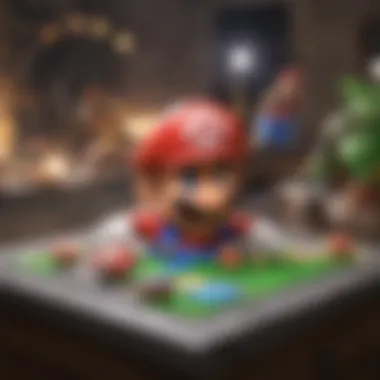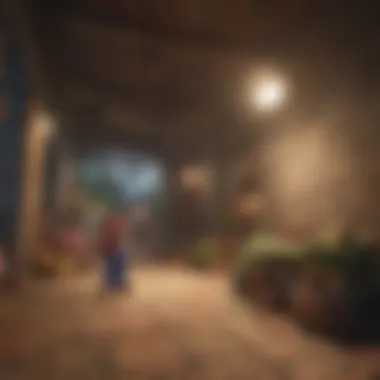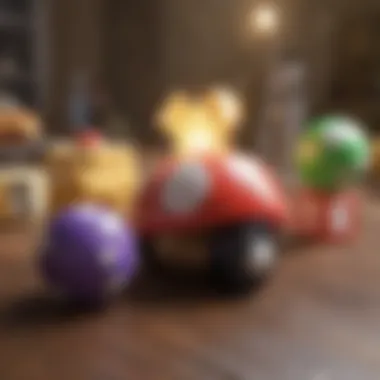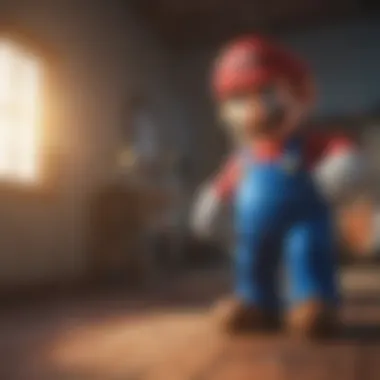A Deep Dive into Mario Party 7 for GameCube


Intro
Mario Party 7, released for the Nintendo GameCube in 2005, stands as a remarkable entry in the storied franchise. Crafting a blend of fun, strategy, and sometimes a dash of chaos, this title has earned its place in the hearts of many gamers. The world of Mario Party is known for its frantic minigames and competition among friends, and Mario Party 7 brings that signature experience with its unique flavor and features.
With an enriched character roster and vibrant board designs, it's not just a game; it's a canvas where friendships are both forged and tested under the pressures of competition. In this article, we will take you through various elements of Mario Party 7, examining everything from its gameplay mechanics to its lasting influence on both the Mario series and the wider party game genre.
The aim is simple: to provide you, whether you're a casual gamer or die-hard fan, a thorough understanding of what makes Mario Party 7 a pivotal title in Nintendo's roster. Let's get started by delving into the reviews to see how this game has been received over the years.
Preamble to Mario Party
In a realm where players gather for laughter and competition, Mario Party 7 stands as a notable entry in the gaming landscape. This vibrant title not only entertains but embodies the essence of multiplayer interaction, allowing friends and foes to immerse themselves in a rich tapestry of games and camaraderie. In this article, we will peel back the layers of this GameCube classic, diving into its gameplay features, character roster, board designs, and overall impact on the Mario franchise as well as the party game genre.
Historical Context of Mario Party Series
The Mario Party series kicked off its journey in 1998, bringing together beloved Nintendo characters in an accessible yet competitive environment. Keeping up with the trends of gaming during that era, it blended board gameplay with mini-games. By the time Mario Party 7 was released in 2005, the series had already showcased a wide array of innovations. Each installment attempted to introduce fresh ideas, while still holding onto what fans loved about the series.
The development of Mario Party 7 can be viewed as a culmination of previous experiences. With each game, developer Hudson Soft refined the formula, learning from player feedback and utilizing improved technology available at the time. As such, Mario Party 7 was met with a more discerning audience, eager for unique content and interactive experiences. The context of its release is pivotal for understanding its place in gaming history—a product of evolving player expectations and advancements in game design.
Release and Development Timeline
Mario Party 7 was released in North America on October 24, 2005. The timeline of Mario Party 7 includes several significant milestones:
- Initial Conceptualization (2003-2004): The development team began drafting ideas for the new features that would distinguish this entry from its forebears, including new boards and an expansive mini-game selection.
- Development Phase (2004): Hudson Soft engaged in rigorous testing, ensuring that game balance and mechanics were polished. They invested time in enhancing the game's graphics and sound design to match the rising expectations of players.
- Launch Preparation (Late 2005): In the lead-up to the game’s release, marketing campaigns emphasized multiplayer experiences, tapping into the growing trend of social gaming.
Ultimately, by blending older elements with fresh ideas and improvements, Mario Party 7 not only carved its own niche but also contributed to the legacy of the series. Its release marked an important milestone, inviting both familiar faces and newcomers to enjoy the vibrant world of Mario.
"The party is always at its best when everyone brings their A-game!"
In summary, Mario Party 7's place in the historical context of the Mario Party series and the precise moments leading to its release lay the groundwork for the extensive exploration of gameplay mechanics, thematic elements, and cultural significance that follows in this article.
Gameplay Mechanics
When diving into Mario Party 7, the heart of the experience lies in its gameplay mechanics. These are not just elements stitched together; they are the lifeblood of the game that blends strategy, luck, and social interaction. At its core, the gameplay mechanics encompass various facets, from the layout of the game boards to the interactive minigames. The interplay of these components is designed to encourage competitiveness among players while also fostering a sense of camaraderie. The strategic depth offered is vital for keeping players engaged, as each turn can shift the balance of power, making every decision weighty.
Game Boards Overview
Board Layout and Themes
The board layout in Mario Party 7 is not merely a canvas on which the game unfolds; it serves as a dynamic playing field that influences player strategy. Each board boasts a unique theme—from tropical paradises to spooky castles—inviting players into distinct worlds that enhance the gameplay experience. The depth of the board design is significant because it caters to various player preferences, enriching the overall atmosphere.
One standout feature of the boards is the paths that lead to different outcomes based on player choices. This element of choice increases replayability since players can experience varied scenarios each time they play. However, the complex design of some boards may overwhelm new players, as diverse paths can lead to confusion in strategy. Overall, however, the design is a beneficial aspect that creates engaging gameplay.
Strategic Elements


Strategic elements play a crucial role in determining the course of the game. Choices made by players during their turns can impact not just their fate but also that of their opponents. One of the key characteristics is the incorporation of items, which players can acquire and use strategically. Timing and decision-making around item usage can help turn the tides, making this a much-loved feature.
Incorporating strategy into the core gameplay encourages players to think critically about their moves. They aren’t just rolling dice; they are plotting revenge or friendship with each turn. Despite the strategic depth being a major draw, an overemphasis on tactics can sometimes eliminate the game's fun, especially for casual gamers.
Minigame Structure
Diversity of Game Types
The minigames in Mario Party 7 showcase an impressive diversity that keeps players on their toes. This variety ensures that everyone from casual gamers to seasoned veterans can find something they enjoy. The inclusion of fast-paced challenges alongside more intricate ones means that every game session can feel fresh.
A key feature is the range of minigame types, from luck-based games to those requiring motor skills. This balance allows all players to shine in particular segments. However, the relentless shifting of game styles may also frustrate those who prefer mastery over chance, leading to mixed feelings about the overall experience.
Multiplayer Dynamics
Multiplayer dynamics are where Mario Party 7 truly shines. The game thrives on its ability to generate memorable social interactions. Players often find themselves sharing in both triumph and defeat, creating a lively atmosphere. The characteristic of friendly rivalry is heightened in multiplayer settings where betrayal is not only expected but sometimes planned.
This emphasis on social gameplay makes Mario Party 7 an excellent choice for parties or gatherings. However, it could be argued that for players seeking a more solitary gaming experience, its multiplayer focus might not seem appealing. Nevertheless, the fun found in battling your friends cannot be overstated.
Character Selection and Abilities
Character Roster
The character roster in Mario Party 7 is eclectic, featuring familiar faces from the Mario universe. Characters like Mario, Luigi, and Peach bring their own flair, impacting gameplay in subtle ways. This diversity of characters allows for different playstyles depending on player preference.
A significant aspect of the character selection is the ability to tailor gameplay experiences. Choosing a character that resonates can enhance player investment in the game. However, some players argue that certain characters feel overpowered, shifting the balance away from fairness, which can lead to issues in competitive play.
Unique Abilities
Each character comes with unique abilities that add another layer to the gameplay. Some characters might have advantages in certain minigames or special interactions on the board. This element encourages players not only to select characters based on preference but also to use them strategically during gameplay.
While the unique abilities enrich the game, they also come with their own pitfalls. Players may find their choices limited by the power dynamics in play, leading to a potential lack of diversity in character selection during highly competitive matches. Ultimately, these abilities contribute to the overall experience, offering layers of strategy and fun.
Thematic Elements
The thematic elements of Mario Party 7 play a crucial role in engaging players and enriching their gameplay experience. Themes offer a framework that enhances the narrative, influences player strategy, and ties the various elements of the game into a cohesive package. In Mario Party 7, numerous motifs emerge through its visuals and sounds, which together enhance the lively spirit of friendly competition.
Visual Aesthetics and Art Style
The visual aesthetics of Mario Party 7 are characterized by vibrant colors and imaginative art design. Each game board presents its own lively theme, be it the tropical splendor of "Jungle Adventure" or the whimsical charm of "The Bowser War Room." These visual choices not only captivate players but create a sense of immersion.
The characters are well-rendered and expressive, each animated with quirky gestures and movements that bring them to life. The textures used are rich, making the overall experience visually appealing and inviting. It can be said that the art style leans into a cartoonish approach, which tends to resonate well with both younger players and nostalgic adults.
Additionally, the dynamic backgrounds shift and change along as the game progresses, which adds layers to player engagement. You might spot a few classic Mario enemies popping out, playful waves crashing on the shores, or even fireworks during special moments. These minute details keep the visual experience fresh and enjoyable.
Sound Design and Music


Now, let’s tune into the sound design of Mario Party 7. Sound plays a significant part in how we perceive the game. The catchy tunes that accompany each board add to the atmosphere, making it a delightful experience overall. The music ranges from upbeat melodies during bustling game phases to whimsical tunes in minigames.
The unique sound effects contribute significantly to player interactions. From the cheerful jingles each time a player lands on a special space to the faint grumbling of Bowser, the soundscape enhances every playthrough and makes it memorable. You can almost sense the tension build as the music shifts, warning players of some impending doom or an exciting reveal.
"The key success of a party game like this lies in its ability to blend a visual and auditory experience that keeps players returning for more, and Mario Party 7 does just that."
In terms of multiplayer dynamics, the sounds also play a pivotal role. The laughter and cheers from local players meld with the in-game music, crafting a communal experience that transcends individual play. As friends and family gather to play, the sounds of laughter paired with the engaging score set the stage for joyous memories.
Critical Reception and Impact
The reception of Mario Party 7 played a crucial role in solidifying its position within the Mario franchise and the party game genre at large. With its combination of engaging gameplay mechanics, a rich array of minigames, and a focus on multiplayer fun, the critical response was varied, yet consistently highlighted the game's procedural fun factor. The importance of reviews lies not only in shaping consumer perceptions but also in influencing future titles within the series.
Reviews and Ratings
When examining reviews and ratings for Mario Party 7, several sources painted a broad spectrum of opinions. Gaming magazines and websites wield significant influence, presenting both praise and critiques that can sway public interest. Most notably, Game Informer lauded the game for its vast minigame selection and charm, granting it a rating of 8.5 out of 10. Meanwhile, IGN noted some repetitiveness in gameplay and offered a more reserved score of 7.3, stressing the need for fresh ideas.
Such mixed reviews underline a paradox in Mario Party 7: while some elements were celebrated, others were termed commonplace. A common point of praise was the game’s ability to facilitate local multiplayer interaction, which remains a core appeal for party games. Critics consistently pointed out this aspect as a reason to gather friends, with many stating that it truly shines when enjoyed in a group setting.
Ultimately, the balance of joy and critique in reviews paints a vivid picture of how Mario Party 7 was perceived. Reviews serve as a reflection of community sentiments, and they underpin the impact this title has had on fans, encouraging candid discourse on its strengths and weaknesses.
Comparative Analysis with Predecessors
In comparing Mario Party 7 with its predecessors, one can identify both advancements and areas where it tread familiar ground. Unlike earlier titles, which were seen as more linear and formulaic, Mario Party 7 introduced mechanisms that offered slightly nuanced gameplay.
- Broader Minigame Array: Mario Party 7 brought in new styles of minigames incorporating varied mechanics, enhancing the overall gameplay experience. For instance, Tilt-a-Shell and Duel Mini-Games served to diversify play.
- Online Features: For the first time in the series, although limited, there were incremental steps toward online play which established foundations for future titles in the series to build upon.
- Character Interactions: The introduction of more conversational elements between characters also set it apart; this added layers to player dynamics not fully exploited in prior games.
The lag in innovation seen in other aspects, such as board designs and game objectives, was noted by many players who felt certain stations felt rehashed. The familiar design and mechanics caused some to yearn for more radical changes rather than just adaptations. This contrast highlights a tension in series evolution—balancing what made it popular while seeking to refresh its appeal with new features.
"Each new entry has to walk a fine line between nostalgia and innovation. Mario Party 7 did this well enough to keep fans engaged, but its successors had to do much more to wow players."
Cultural Significance
The cultural significance of Mario Party 7 is more than just about the game itself. It encapsulates the very essence of social gaming during the era of the Nintendo GameCube, representing a pivotal slice of gaming history that emphasizes local multiplayer experiences. This title not only added to the Mario franchise but also influenced how social interactions occurred in video gaming spaces.
Community and Multiplayer Environment
Local Play and Social Interaction
Local play in Mario Party 7 stands out as a hallmark feature of the game. This aspect greatly contributes to the engaging nature of the gameplay. Many players gathered in living rooms, controllers in hand, ready to battle it out over various mini-games and board tactics. Friends and family would often turn what could be a mundane evening into a lively competition filled with laughter and sometimes friendly banter. The core characteristic here is the face-to-face interaction, which is increasingly rare in today’s gaming landscape where online play often takes precedence.
One unique feature of local play in Mario Party 7 is its design to accommodate up to eight players. This broadened the game's appeal significantly, allowing large groups to join in the fun. Furthermore, the party atmosphere facilitated by the game enhanced social bonds, as players exchanged not just strategies but also stories and memorable moments. However, a potential disadvantage could be that not all friends would possess the game or the console, which limits access. Despite that, the communal aspect of sharing the gaming experience tends to outweigh any drawbacks, fostering a sense of togetherness.
Online Legacy


As for the online legacy, while Mario Party 7 was primarily a local multiplayer game, it laid the groundwork for integrating online features in future iterations. Players began to crave connectivity and the ability to engage with friends who were miles away. This shift towards recognizing the importance of an online platform also echoed across the gaming community—paving the way for a more connected experience in subsequent Mario titles.
The key characteristic of the online legacy lies in its evolution; it brought forth a new way to enjoy the familiar mechanics while expanding the player base. A unique component that emerged from this advancement is the ability to replay minigames and board levels with friends in different geographical locations. Although lacking in the robust online features of modern games, the awareness it generated highlighted how pivotal online connectivity could be—an essential feature that has since become standard in gaming.
Influence on Future Mario Games
The influence of Mario Party 7 on future Mario games is evidenced not only in the mechanics of play but also in design philosophy. Its successful combination of competitive gameplay with cooperative elements encouraged subsequent titles to find the same balance. The game’s structure inspired developers to consider the dynamics of group play in a way that both entertained and fostered rivalry among friends. As a result, we see games that followed adopt similar social-centric gameplay, reinforcing the lasting legacy of Mario Party 7.
Legacy of Mario Party
Mario Party 7 holds a unique place within the pantheon of console gaming, especially in the context of party games. Its impact isn't merely a footnote in a history of iconic titles; it heralds an era that solidified the Mario Party series as the go-to choice for group gaming. In this section, we'll explore both its modern implications and the vibrant fan community that continues to reflects its legacy.
Modern Relevance
Continuations in the Series
Mario Party 7 has certainly paved the way for subsequent entries in the series. It introduced mechanics that would persist, such as the Duel mode and various party boards that kept fresh gameplay flowing throughout. This continuity is not just a matter of gameplay elements but also underscores an ongoing engagement with the audience.
The unique feature of Mario Party 7 was its focus on cooperative gameplay alongside the classic competition, setting the stage for later titles to explore deeper mechanics. This duality has made it a beneficial choice for series continuity, enriching the experience and allowing characters to interact in more meaningful ways. On the flip side, while some may find it a bit repetitive, the nostalgic factor tends to outweigh the downsides for avid fans.
Nostalgia Factor
Nostalgia plays a formidable role in the longevity of Mario Party 7. For many gamers, this title acts as a time capsule, evoking memories of countless late-night gaming sessions with friends and family. Not only does it hold a special place in the hearts of those who played it, but it also serves as an entry point for new players who wish to understand the roots of the franchise.
Interestingly, its nostalgic value isn't simply about the fun; it evokes broader sentiments related to friendship and shared experiences, making the nostalgia factor a crucial element in discussions of its legacy. However, while it recalls fond memories, some might argue that it has set an unreachable bar for newer games in terms of emotional investment.
Fan Community and Retrospectives
The fan community surrounding Mario Party 7 remains fervent and deeply invested. From engaging discussions on Reddit to heartfelt retrospectives on platforms like Facebook, the legacy isn't just about the game itself but about shared experiences and memories. Analysis of individual minigames, board strategies, and character selection is frequent fodder for discussion.
“Mario Party 7 wasn’t just a game, it was a gathering,” wrote one avid fan in a Reddit post, highlighting that the social element remains its strongest appeal.
Fans craft mods and academic retrospectives to keep the conversation alive, ensuring that even as gaming evolves, Mario Party 7’s significance does not fade into obscurity. As such, the community not only keeps the game alive through remembrance but also acts as a lens to view how merriment evolves in gaming circles.
In summary, the legacy of Mario Party 7 isn’t merely tied to its gameplay mechanics but also to the emotional weight and community that has built up around it. Its modern relevance and nostalgia serve as vital threads in the fabric of gaming culture, making it a topic worthy of continued discussion.
Ending
The significance of Mario Party 7 cannot be understated for anyone who's taken a seat at this vibrant gaming table. It’s not just another game; it represents a milestone in the Mario Party franchise and party games as a whole. The various gameplay features—from cleverly designed boards to unique mini-games—demonstrate a rich depth that captures the attention and enthusiasm of both casual players and hardcore fans.
Final Thoughts on Gameplay Experience
As players embark on their journeys through the whimsical worlds crafted in Mario Party 7, they are met with a blend of strategy and luck. Each round is peppered with surprises, whether it’s a friendly rivalry in a mini-game or a twist that changes the course of the game entirely. The character roster provides not just visual diversity, but each character offers a unique gameplay advantage, promoting various strategies depending on who you choose to play.
Engagement goes beyond merely pressing buttons; it’s about the social interactions that unfold as players navigate the board, share laughs, and maybe even a few competitive jabs. The atmosphere of local multiplayer feels organic and chaotic, echoing every friend’s living room from the early 2000s. Moreover, the nostalgia factor resonates with long-time players, reminding them of simpler times spent in front of the TV with friends.
In summary, the true essence of Mario Party 7 lies in its capacity to bring people together. It blurs the lines between competition and cooperation, ultimately crafting experiences that linger far beyond the game itself. It may be just a game to some, but to many, it is a cherished memory, a story to tell, and a vivid reminder of friendship.
"Mario Party is more than just a game; it's a bond that brings friends and family together, turning rivals into allies and strangers into friends."
As we put down our controllers, we’re left with more than just scores and rankings. We leave with moments that become tales worth sharing, all thanks to the unique experiences Mario Party 7 offers. The impact it leaves on players—new and old alike—stands as a testament to its enduring legacy in the realm of gaming.



